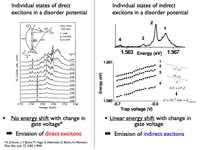In-plane disorder |
|

|
In-plane random potential is caused by interface and alloy fluctuations, defects and impurities, and is an intrinsic feature of QW samples (and of solid state materials in general). High quality samples are characterized by small amplitude and large length scale of the random potential. This is revealed by small linewidth of exciton PL. Individual exciton states in disorder potential produce sharp emission lines. A. Zrenner, L. V. Butov, M. Hagn, G. Abstreiter, G. Böhm, and G. Weimann, Quantum dots formed by interface fluctuations in AlAs/GaAs coupled quantum well structures, Phys. Rev. Lett. 72, 3382-3385 (1994) A.A. High, A.T. Hammack, L.V. Butov, L. Mouchliadis, A.L. Ivanov, M. Hanson, and A.C. Gossard, Localization and interaction of indirect excitons in GaAs coupled quantum wells, arXiv:0804.4886v1 (2008) A.A. High, A.T. Hammack, L.V. Butov, L. Mouchliadis, A.L. Ivanov, M. Hanson, and A.C. Gossard, Indirect excitons in elevated traps, Nano Lett., 9 (5), 2094 - 2098 (2009). |

|
Moderate in-plane random potential improves conditions for the exciton condensation in local potential energy minima due to the local enhancement of the exciton density and confinement effects. Exciton condensate in a random potential is analogous to the "Bose-glass" phase, or to a random Josephson-junction array in superconductors. L.V. Butov and A.I. Filin, Anomalous transport and luminescence of indirect excitons in AlAs/GaAs coupled quantum wells as evidence for exciton condensation, Phys. Rev. B 58, 1980 (1998) L.V. Butov and A.I. Filin, Energy relaxation and transport of indirect excitons in AlAs/GaAs coupled quantum wells in high magnetic fields, Zh. Eksp. Teor. Fiz. 114, 1115 (1998) [JETP 87, 608-611 (1998)] L.V. Butov, A. Imamoglu, A.V. Mintsev, K.L. Campman, and A.C. Gossard, Photoluminescence kinetics of indirect excitons in GaAs/AlGaAs coupled quantum wells, Phys. Rev. B 59, 1625 (1999) With the increase of the potential fluctuations the sizes of the condensate lakes (as well as the correlations between the lakes) are reduced, and at large random potential the exciton condensate disappears. Therefore, in order to observe the exciton condensate, high quality samples with small potential fluctuations are required. No condensation effects are observed in samples with a large random potential. L.V. Butov, A.V. Mintsev, A.I. Filin, and K. Eberl, Kinetics of indirect photoluminescence in GaAs/AlGaAs double quantum wells in a random potential with a large amplitude, Zh. Eksp. Teor. Fiz. 115, 1890 (1999) [JETP 88, 1036 (1999)] |
 |

|